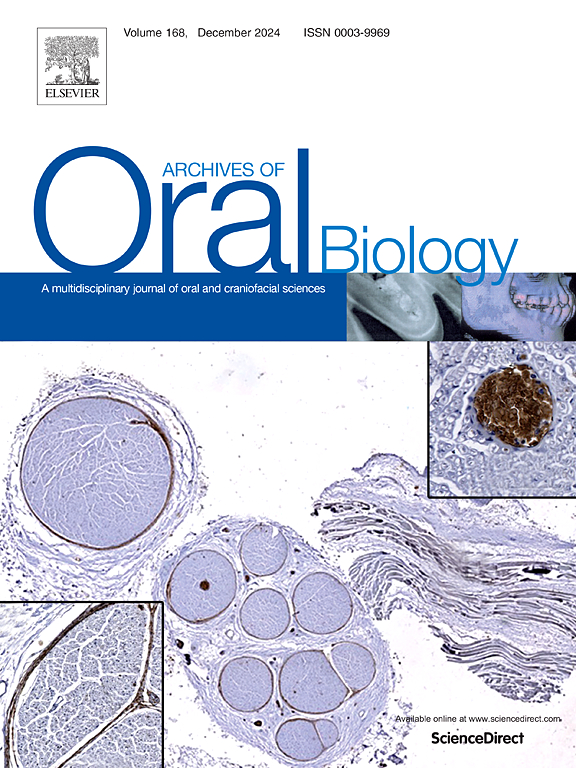肥胖儿童牙本质再矿化使用自组装肽P11-4和氯磷酸钙:一项离体研究
IF 2.1
4区 医学
Q2 DENTISTRY, ORAL SURGERY & MEDICINE
引用次数: 0
摘要
目的唾液是口腔主要的防御剂。肥胖儿童的唾液成分与健康儿童不同。本研究的目的是通过使用P11-4和CCPS来评估肥胖儿童与健康儿童唾液中的再矿化效应。在凝胶诱导脱矿后,将20个P11-4和20个CCPS处理过的牙盘浸泡在健康和肥胖儿童的天然全唾液中(n = 10)。在基线、7天(T1期)和28天(T2期)进行显微ct和扫描电镜(SEM)分析。结果sccps能提高矿质成分的含量,降低病变深度的效果显著。2组疗效最高,为68.8% %,3组疗效最低。与健康儿童相比,暴露于肥胖儿童唾液中的P11-4和CCPS的疗效降低。P11-4在T1期表现出更明显的病变深度减少;然而,其有效性随着T2期唾液暴露时间的延长而降低。再矿化效果的百分比是根据正常的牙本质值对数据进行归一化后计算的。双因素方差分析显示,两组间仅在T2期存在显著差异(p <; 0.005)。扫描电镜显示明显的矿物沉积和小管阻塞。各组之间存在很大差异,CCPS控制组显示出最有效的小管密封。P11-4组表现出最小的管状闭塞。结论与P11-4相比,健康儿童唾液中ccps 28 d后的再矿化效果增强。本文章由计算机程序翻译,如有差异,请以英文原文为准。
Dentinal remineralisation using self-assembling peptide P11-4 and chloro calcium phosphosilicate in obese children: An ex vivo study
Objective
Saliva acts as primary oral defence agent. Obese children’s saliva differs in composition from healthy children. The objective of the study was to evaluate the remineralization effects in saliva from obese versus healthy children by using P11–4 and CCPS.
Design
After gel induced demineralisation, 20 P11–4 and 20 CCPS treated dentinal discs were submerged in natural whole saliva collected from healthy and obese children (n = 10). Micro-CT and Scanning Electron Microscopy (SEM) analyses were performed at baseline, 7-days (T1 stage), and 28-days (T2 stage).
Results
CCPS had enhanced mineral content percentage and significantly greater efficacy in lowering lesion depth. Group 2 displayed the most efficacy at 68.8 %, while Group 3 showed the lowest efficacy. P11–4 and CCPS demonstrated diminished efficacy when exposed to saliva from obese children compared to healthy ones. P11–4 exhibited a more significant reduction in lesion depth at the T1 stage; however, its effectiveness decreased with extended saliva exposure at T2 stage. The percentage of remineralisation efficacy was calculated after normalising the data against sound dentine values. Two-way ANOVA indicated significant differences across the groups exclusively at stage T2 (p < 0.005). SEM micrographs demonstrated significant mineral deposition and tubule obstruction. There were substantial disparities across groups, with CCPS controls demonstrating the most efficient tubule sealing. The P11–4 group exhibited the minimal tubular occlusion.
Conclusion
CCPS in healthy children saliva after 28-days had enhanced remineralisation efficacy compared to P11–4.
求助全文
通过发布文献求助,成功后即可免费获取论文全文。
去求助
来源期刊

Archives of oral biology
医学-牙科与口腔外科
CiteScore
5.10
自引率
3.30%
发文量
177
审稿时长
26 days
期刊介绍:
Archives of Oral Biology is an international journal which aims to publish papers of the highest scientific quality in the oral and craniofacial sciences. The journal is particularly interested in research which advances knowledge in the mechanisms of craniofacial development and disease, including:
Cell and molecular biology
Molecular genetics
Immunology
Pathogenesis
Cellular microbiology
Embryology
Syndromology
Forensic dentistry
 求助内容:
求助内容: 应助结果提醒方式:
应助结果提醒方式:


